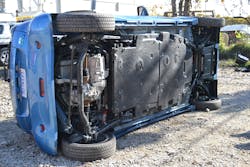University of Extrication: Electric Plug-In Vehicle Stabilization - Part 2
Topic: Electric Plug-In Vehicle (EV) Stabilization, Part 2
Objective: Accomplish effective stabilization of a side-resting EV
Task: Given a side-resting EV with a floorpan-mounted high-voltage lithium-ion battery, the rescue team shall recognize the unusual stabilization challenges and be able to effectively adapt their rescue techniques accordingly.
In Part 2 of this three-part University of Extrication series, we will use a Mitsubishi i-MiEV and a Nissan LEAF to demonstrate key points. Both of these EVs have floorpan-mounted high-voltage (HV) lithium-ion batteries, as do other EV models, such as the Chevy BOLT EV, BMW i3 and various Tesla models.
The stabilizing and rescue tactics used when dealing with a side-resting EV are much different than any other type of vehicle. One significant difference is that the weight of the floorpan-mounted HV battery, positioned beneath the floor of the EV, completely changes the vehicle’s center of gravity and weight balance. Rescuers should be trained to consider the underside of these EVs as being the “heavy” side. Unlike conventional vehicles, an EV is much more likely to lean or move toward the floorpan (or heavy) side of the vehicle.
If one of these EVs were side-resting and on an uneven surface (e.g., up an embankment on the side of a road), the undercarriage side presents a “collapse zone” risk. The weight of the battery makes the vehicle much heavier on the undercarriage side, making it much more prone to leaning or falling back over onto its wheels than we are accustomed to with side-resting internal combustion engine vehicles. It’s almost like the vehicle wants to right itself.
Caution using struts
When a conventional vehicle is side-resting and is being stabilized, we can use almost any area of the undercarriage for placement of stabilization struts. With a side-resting EV, however, most of the floorpan area is off limits to rescue tools due to the presence of the large floorpan-mounted HV battery. Remember, we cannot crush, puncture or otherwise damage any portion of the lithium-ion battery modules or the HV electronics that might be underneath the floor of the EV. That only leaves the upper rocker channel area and a few other small portions of the undercarriage where we can safely place struts for stabilization and avoid the HV battery at the same time.
In company-level extrication drills conducted using conventional vehicles, personnel should also train to become proficient at strut stabilization of a side-resting EV vehicle without using any of the floorpan area. As a training tip, a vehicle rescue instructor could place a conventional vehicle on its side and then spray paint the center of the floorboard a bright color. During the training session, advise the participants that this represents an electric vehicle and the painted undercarriage area represents a lithium-ion battery that is off limits. That simple simulation during routine training will better prepare the responders for stabilization of an actual side-resting EV when they do encounter one at a real-world incident.
Next time
In the concluding segment of this series, we’ll review specific techniques for stabilizing a roof-resting EV that has a floorpan-mounted battery.
SIDEBAR
Considerations When Stabilizing a Side-Resting EV
- Note that the undercarriage side is heavy side
- The floorpan area is off limits for struts
- Use the upper rocker channel for strut stabilization
- The floorboard side is a hazardous collapse-zone area
Read the rest of the series here:
Part 1: Floorpan-mounted batteries can cause challenges for rescuers
Part 3: Roof-resting EVs create several challenges

Ron Moore
RON MOORE, who is a Firehouse contributing editor, recently retired as a division chief with the McKinney, TX, Fire Department and now serves with Prosper, TX, Fire Rescue. He self-published the Vehicle Rescue 1-2-3 training manual and serves as the forum moderator for the extrication section of Firehouse.com . Moore can be contacted directly at [email protected].






